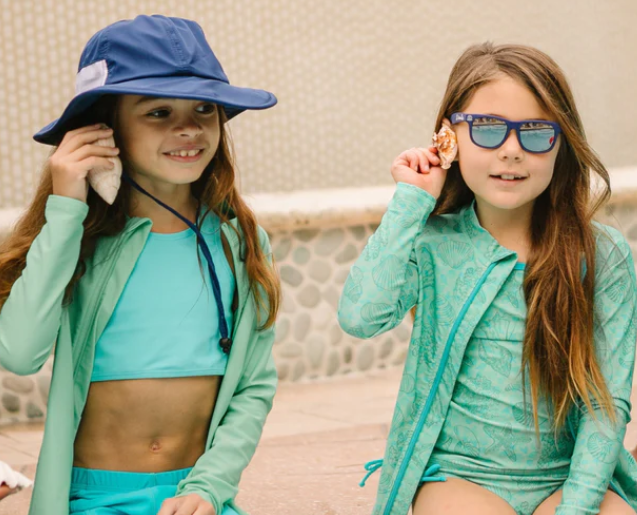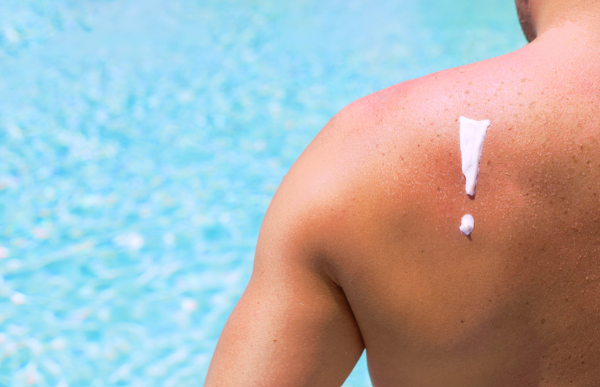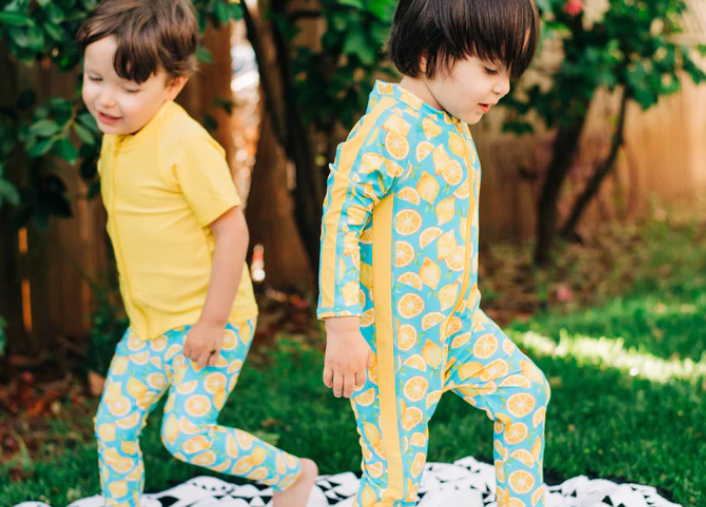
What is UPF?
UPF stands for ultraviolet protection factor. Let’s look into how UPF is measured, which factors affect UPF ratings, and how to select high-UPF clothing.
Quick links:
Why is UPF clothing important?
How do you choose UPF clothing?
SwimZip is a leader in sun protection knowledge and provides trusted sun-protective swimwear, clothing, and accessories. We offer valuable guidance to help you and your loved ones stay safe from sun exposure and provide high-quality, sun-safe clothing options.
What is UPF?
Ultraviolet protection factor is a standard measurement system that indicates how effectively a fabric can block ultraviolet (UVA and UVB) rays from the sun.
The UPF rating labeled on clothing and sun protective gear tells you how much UV radiation can penetrate the fabric to reach your skin. It works similarly to sun protection factor (SPF) ratings for sunscreens but applies specifically to clothing items and textiles.
UPF rating scale
The UPF rating system operates on a numerical scale that indicates how much UV radiation can penetrate a fabric to reach the skin underneath. Similar to SPF for sunscreens, higher UPF ratings denote an increased ability to block ultraviolet rays.
The four ratings found on the UPF rating scale are as follows:
- UPF 15 allows 6.7% UV ray transmission, 93.3% blocked
- UPF 30 allows 3.3% UV ray transmission, 96.7% blocked
- UPF 50 is the maximum rating. It allows 2% (1/50) UV ray transmission, 98% blocked
Based on the percentage of UV rays blocked, different UPF ratings offer a different amount of sunburn protection:
- UPF 15—Extends safe sun exposure without burning by 15 times
- UPF 30—Extends safe sun exposure without burning by 30 times
- UPF 50—Extends safe sun exposure without burning by 50 times
To qualify as protective sun gear, clothing needs a minimum UPF 30 rating. Higher UPF ratings provide even better protection, with UPF 50+ clothing offering the highest level of protection.
All SwimZip clothing offers excellent protection with a UPF rating of 50+. Our garments block 98% of the sun’s harmful UVA and UVB rays for maximum sun protection.
Which factors affect UPF?
A fabric's UPF rating can vary significantly depending on certain qualities and treatments. The main factors that impact how effectively a clothing article or textile blocks UV rays include:
- Weave tightness
- Material composition
- Fabric weight
- Dyes and colors
- Treatments
- Washing and wear
Weave tightness
The tightness of the fabric weave plays a major role. Tightly woven materials with a higher thread count per inch effectively block more UV rays. Loosely woven fabrics allow more UV rays to pass through the weave and reach the skin.
Material composition
The base material of the textile impacts the UPF rating. High-tech synthetic materials often provide better UV resistance compared to natural fabrics such as cotton and linen. However, some material blends and tight cotton weaves can still provide good protection.
Fabric weight
Heavier, thicker fabrics inherently provide higher UPF protection than very lightweight, sheer materials. Advanced lightweight synthetics can still have a high UPF rating due to fiber quality and construction.
Dyes and colors
The dyes and darker colors used in a fabric contribute to how much UV radiation it absorbs. Deep colors like black, dark blue, and purple offer much higher UPF than bleached, light, or white fabrics.
Treatments
Special UV-blocking treatments can be applied to textiles and clothing, or built into detergents to boost UPF rating. These will inevitably wear off over time with washing and need reapplication.
Washing and wear
When UPF clothing is washed, dried, worn, and stored, the protective qualities will degrade as a result of stretching, sweat, abrasion, and chemicals. You should follow care instructions to assure longevity.
Importance of UPF clothing
Wear clothing with proper UPF to protect your skin from sun damage and reduce UV exposure when spending time outdoors. Sun-protective clothes are important because they:
- Prevent sunburns. Fabrics with suitable UPF ratings significantly delay the onset of redness, pain, and peeling from excessive UV radiation exposure. Even UPF 30 clothing can extend 'safe sun time' before burning by over 30X.
- Lower skin cancer risk. Overexposure to UV is the leading cause of all skin cancers. Robust studies show wearing daily UPF clothing minimizes overall UV damage to the skin over a lifetime, substantially cutting cancer risk.
- Allow safe outdoor activity. Sun-protective clothing gives you the freedom to enjoy the outdoors for hours while staying protected. Whether it is yard work, water sports, hiking, or anything in between, UPF clothing will keep your skin safe.
- Critical for medical conditions. For people with lupus, vitiligo, and skin grafts, doctors recommend always wearing UPF 30+ clothing when going outside, as UV triggers severe reactions.
- Reduce premature aging. UVA rays drive the collagen breakdown that is responsible for sagging skin, wrinkles, and uneven pigmentation. UPF clothing significantly slows down the onset of premature aging from sun exposure.
- Protect tattoos and scars. Tattoo fading and blurring is accelerated by sun exposure without proper UPF coverage. Scars and wounds that are still healing can darken, and ink can fade or be damaged when sunburnt.
- Safeguard children. Children's delicate skin burns fast, and repeated burns exponentially raise the risk of developing melanoma later in life.Things like sun protective swimwear for kids, UPF swimsuits, rash guards, and wide-brim hats are essential.
How do you shop for UPF clothing?
Here are some tips on how to shop for UPF clothing:
Check the label
When shopping for sun-protective clothing, always check the product label or description for the UPF rating. SwimZip has had their fabrics certified and tested to verify the UPF rating. The higher the UPF, the better.
Aim for UPF 50+
All our clothing is rated UPF 50+ which blocks over 98% of UV radiation, providing the highest level of sun protection.
UPF logos
Our clothing line is devoted to sun coverage, and we proudly display a UPF logo so you can easily identify sun-protection items as you browse. This makes selection easier across sun hats, swimwear, shirts, pants, and other clothing that much easier.
Fabric structure
All of our products are crafted from high-performing nylon and spandex materials—the leading fabrics for durability, comfort, and protection. Our quick-dry, chlorine-resistant textile blend offers the highest-rated UPF 50+ protection.
Our stretchy and breathable fabrics allow you to move with ease while staying fully shielded from UV lights.
Styles
We offer UPF 50+ sun protection apparel for the whole family in a variety of styles. Choose from swimsuits, swim dresses, one-piece suits, sun hats, long sleeve rash guards, and more. We have stylish options for babies, kids, and adults so everyone enjoys safe coverage at the pool, beach, or water sports adventures.
Our wide selection of protective gear ranges from our signature swim leggings and surf shirts to cute sunsuits for little ones.
UPF clothing care
To keep your sun protective gear in optimal condition, be mindful when washing and storing your UPF clothing. Fabrics with tighter weaves and darker fabrics will maintain their protective qualities for longer over multiple wears and washes. Lighter colors and more delicate materials are prone to fading and degradation, and will lose their effectiveness quicker.
When machine washing UPF clothing, use mild detergent and delicate cycles for sensitive fabrics. Avoid very hot water or aggressive scrubbing that can damage fibers; wash similar UPF items together. Line or flat drying is recommended rather than high heat which accelerates deterioration.
Proper storage away from direct light will also maximize lifespan. Follow all garment care instructions to ensure your UPF gear maintains its excellent sun-blocking performance season after season. Reapply UV protective treatments as needed.
SPF vs. UPF
When it comes to sun protection, you may have seen both SPF and UPF ratings and wondered “what’s the difference?”
SPF stands for “sun protection factor”. SPF rating applies to topical skin products such as sunscreens and oils that get applied directly onto your skin. SPF indicates how well the sunscreen formulation blocks UVB rays from causing sunburns. Higher SPF ratings means a longer period of protection before skin damage occurs.
UPF rating applies specifically to fabrics and clothing textiles. UPF measures how effectively types of fabrics can block both UVA and UVB rays from reaching the skin.
While SPF and UPF ratings work on similar principles of blocking UV radiation, key differences include:
- SPF applies to lotions and other topicals, while UPF measures fabric efficiency.
- SPF only factors in UVB rays; UPF measures combined UVA+UVB protection.
Both SPF and UPF are important for overall sun safety. Dermatologists advise wearing sunscreen under your UPF hat and clothing for comprehensive UV defense when spending extended periods of time in the sun. The combination of SPF and UPF protection works better than either method on its own.
Stay safe with SwimZip
SwimZip is dedicated to promoting sun-safe fun by developing and delivering sun-protective products that are stylish, functional, and affordable. We have become one of the most trusted UPF 50+ brands that people use to keep themselves and their loved ones safe from the sun.
We look forward to many more years of making UV protection a zip!
UPF FAQ
Can you get burned through UPF 50+?
While UPF 50+ clothing offers excellent UV protection, it is not completely impervious to UV rays. A rating of UPF 50+ blocks 98% of UV radiation from reaching your skin, but the 2% that does penetrate can still cause damage.
While UPF 50+ clothing significantly reduces the risk of sunburn, it is not entirely impossible
Do you really need UPF clothing?
UPF clothing is not a necessity for everyone, but it is a highly effective form of sun protection. It is particularly beneficial for individuals who spend a lot of time outdoors, have a history of skin cancer, or have sensitive skin. UPF clothing provides consistent, unwavering protection, unlike sunscreen that needs to be reapplied, and can be a more convenient and reliable option.
What is the healthiest SPF to use?
The healthiest SPF to use can vary depending on your skin type, the intensity of the sun, and the duration of exposure. Dermatologists often recommend using a broad-spectrum sunscreen with an SPF of at least 30, which blocks 97 percent of UVB rays.
Higher SPFs block slightly more UVB rays, but no sunscreen can block 100 percent of UVB rays. It is important to apply sunscreen properly and reapply every two hours or after swimming or sweating.
What is the best color for UV protection?
Dark colors, especially black, dark blue, and dark red pigments are the best at absorbing UVA and UVB rays, and are therefore best at protecting from UV damage. Lighter colors and bleached whites allow the most UV radiation to pass through, versus darker hues in clothing fabrics and dyes. Bright colors and fluorescents let high levels of UVs through.
Do normal clothes block UV rays?
Normal clothes do provide some level of protection, but it is often much lower than that of UPF-labeled clothing. For example, a typical white T-shirt has a UPF of about 7, which drops to a UPF of only 3 when wet. Densely woven fabrics like denim can provide much higher UPF levels.
The effectiveness of normal clothes in blocking UV rays depends on factors such as the fabric's weave, color, weight, and condition.
What is the best alternative to sunscreen?
The best alternative to sunscreen is wearing sun-protective clothing. Clothing is one of the most effective forms of sun protection because it absorbs or blocks harmful UV radiation and does not require reapplication. UPF-labeled clothing, wide-brimmed hats, and UV-filtering sunglasses are excellent alternatives to sunscreen, though they should be used in addition to sunscreen for the best protection.
What is the most protective fabric for UPF-rated clothing?
The most protective fabrics for UPF-rated clothing are those that have a thick, tight weave, and are made from synthetic fibers like polyester or nylon. These materials disrupt UV light effectively. Wool and silk are also moderately effective. Less effective fabrics, such as cotton, rayon, flax, and hemp, often have low UPF ratings without added treatments.
Does UPF clothing work when wet?
UPF clothing retains its UV protection capability when wet, making it one of the best tools for skin protection in pools, water sports, and humid sweaty weather. Chlorine and saltwater can degrade fibers quicker than freshwater, so wash your UPF clothing regularly.
Helpful information
UPF vs SPF: what is the difference?
Resources
Ilyas, E. (2022, July 27). An Overview of Ultraviolet-Protective Clothing - PMC. NCBI. Retrieved February 21, 2024, from https://www.ncbi.nlm.nih.gov/pmc/articles/PMC9414157/



Leave a comment
This site is protected by hCaptcha and the hCaptcha Privacy Policy and Terms of Service apply.